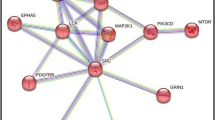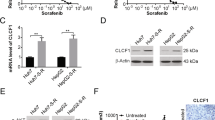Abstract
The reciprocal suppression of an RNA-binding protein LIN28 (human abnormal cell lineage 28) and miRNA Let-7 (Lethal 7) is considered to have a prime role in hepatocellular carcinoma (HCC). Though targeting this inhibition interaction is effective for therapeutics, it causes other unfavorable effects on glucose metabolism and increased insulin resistance. Hence, this study aims to identify small molecules targeting Lin28/let-7 interaction along with additional potency to improve insulin sensitivity. Of 22,14,996 small molecules screened by high throughput virtual screening, 6 molecules, namely 41354, 1558, 12437, 23837, 15710, and 8319 were able to block the LIN28 interaction with let-7 and increase the insulin sensitivity via interacting with PPARγ (peroxisome proliferator-activated receptors γ). MM-GBSA (Molecular Mechanics-Generalized Born Surface Area) analysis is used to re-score the binding affinity of docked complexes. Upon further analysis, it is also seen that these molecules have superior ADME (Absorption, Distribution, Metabolism, and Excretion) properties and form stable complexes with the targets for a significant period in a biologically simulated environment (Molecular Dynamics simulation) for 100 ns. From our results, we hypothesize that these identified 6 small molecules can be potential candidates for HCC treatment and the glucose metabolic disorder caused by the HCC treatment.







Similar content being viewed by others
Data availability
The datasets generated during and/or analyzed during the current study are available from the corresponding author on reasonable request.
Abbreviations
- 2D:
-
Two-Dimensional
- 3D:
-
Three-Dimensional
- ADME:
-
Absorption, Distribution, Metabolism and Excretion
- B3LYP:
-
Backe’s three Lee-Yang-Parr
- DFT:
-
Density Functional Theory
- EMM:
-
Molecular Mechanics Energies
- GNP:
-
Non-Polar solvation
- GSGB:
-
SGB polar solvation model
- H-bonds:
-
Hydrogen Bonds
- HCC:
-
Hepatocellular carcinoma
- HOMO:
-
Highest Occupied Molecular Orbital
- HTVS:
-
High Throughput Virtual Screening
- Let-7:
-
Lethal 7
- LIN28:
-
Human abnormal cell lineage 28
- LUMO:
-
Lowest Unoccupied Molecular Orbital
- MD:
-
Molecular Dynamics simulation
- MESP:
-
Molecular Electrostatic Potential
- miRNA:
-
microRNA
- MM-GBSA:
-
Molecular Mechanics-Generalized Born Surface Area
- NPT:
-
Isothermal–isobaric ensemble
- OPLS:
-
Optimized Potential for Liquid Simulation
- OPLS-AA:
-
Optimized Potential for Liquid Simulation- All Atom
- PPARγ:
-
Peroxisome Proliferator-Activated Receptorsγ
- PBF:
-
Poisson Boltzmann Finite
- QPlogS:
-
Aqueous solubility
- QPPCaco :
-
Caco-2 cell permeability
- QPlogHERG:
-
IC50 value for blockage of HERG K+ channels
- QPlogPo/w:
-
Octanol/water partition coefficient
- RMSF:
-
Root Mean-Square Fluctuation
- RMSD:
-
Root Mean-Square Deviation
- RNA:
-
Ribonucleic Acid
- SP:
-
Standard Precision
- SPC:
-
Simple Point Charge
- SD:
-
Standard Deviation
- XP:
-
Extra Precision
- ZKD:
-
Zinc Knuckle Domain
- PCA:
-
Principal Component Analysis
- FEL:
-
Free Energy Landscape
References
Siegel RL, Miller KD, Wagle NS, Jemal A. Cancer statistics, 2023. CA Cancer J Clin. 2023. https://doi.org/10.3322/caac.21763.
Sathishkumar K, Chaturvedi M, Das P, Stephen S, Mathur P. Cancer incidence estimates for 2022 & projection for 2025: result from National Cancer Registry Programme, India. Indian J Med Res. 2022. https://doi.org/10.4103/ijmr.ijmr_1821_22.
Zhou J, Ng SB, Chng WJ. LIN28/LIN28B: an emerging oncogenic driver in cancer stem cells. Int J Biochem Cell Biol. 2013. https://doi.org/10.1016/j.biocel.2013.02.006.
Mizuno R, Kawada K, Sakai Y. The molecular basis and therapeutic potential of Let-7 MicroRNAs against Colorectal Cancer. Can J Gastroenterol Hepatol. 2018. https://doi.org/10.1155/2018/5769591.
Roos M, Pradère U, Ngondo RP, et al. A small-molecule inhibitor of Lin28. ACS Chem Biol. 2016. https://doi.org/10.1021/acschembio.6b00232.
Wang L, Rowe RG, Jaimes A, et al. Small-molecule inhibitors disrupt let-7 Oligouridylation and Release the selective blockade of let-7 Processing by LIN28. Cell Rep. 2018. https://doi.org/10.1016/j.celrep.2018.04.116.
Lightfoot HL, Miska EA, Balasubramanian S. Identification of small molecule inhibitors of the Lin28- mediated blockage of pre-let-7 g processing. Org Biomol Chem. 2016. https://doi.org/10.1039/c6ob01945e.
Borgelt L, Li F, Hommen P, et al. Trisubstituted pyrrolinones as small-molecule inhibitors disrupting the Protein-RNA Interaction of LIN28 and Let-7. ACS Med Chem Lett. 2021. https://doi.org/10.1021/acsmedchemlett.0c00546.
Lorenz DA, Kaur T, Kerk SA, Gallagher EE, Sandoval J, Garner AL. Expansion of cat-ELCCA for the Discovery of small molecule inhibitors of the Pre-let-7-Lin28 RNA-Protein Interaction. ACS Med Chem Lett. 2018. https://doi.org/10.1021/acsmedchemlett.8b00126.
Goebel GL, Hohnen L, Borgelt L, et al. Small molecules with tetrahydroquinoline-containing Povarov scaffolds as inhibitors disrupting the Protein-RNA interaction of LIN28-let-7. Eur J Med Chem. 2022. https://doi.org/10.1016/j.ejmech.2021.114014.
Lim D, Byun WG, Park SB. Restoring Let-7 microRNA Biogenesis using a small-molecule inhibitor of the Protein-RNA Interaction. ACS Med Chem Lett. 2018. https://doi.org/10.1021/acsmedchemlett.8b00323.
Hommen P, Hwang J, Huang F, Borgelt L, Hohnen L, Wu P. Chromenopyrazole-peptide conjugates as small-molecule based inhibitors disrupting the Protein-RNA Interaction of LIN28-let-7. ChemBioChem. 2023. https://doi.org/10.1002/cbic.202300376.
Borgelt L, Huang F, Hohnen L, et al. Spirocyclic chromenopyrazole inhibitors disrupting the Interaction between the RNA-Binding protein LIN28 and Let-7. ChemBioChem. 2023. https://doi.org/10.1002/cbic.202300168.
Zhang Q, Shi M, Zheng R, Han H, Zhang X, Lin F. C1632 inhibits ovarian cancer cell growth and migration by inhibiting LIN28B/let-7/FAK signaling pathway and FAK phosphorylation. Eur J Pharmacol. 2023. https://doi.org/10.1016/j.ejphar.2023.175935.
Tsialikas J, Romer-Seibert J. LIN28: roles and regulation in development and beyond. Development; 2015. 2397 – 404.
Balzeau J, Menezes MR, Cao S, Hagan JP. The LIN28/let-7 pathway in Cancer. Front Genet. 2017. https://doi.org/10.3389/fgene.2017.00031.
Nguyen LH, Zhu H. Lin28 and let-7 in cell metabolism and cancer. Transl Pediatr. 2015. https://doi.org/10.3978/j.issn.2224-4336.2015.01.05.
Wu K, Ahmad T, Eri R. LIN28A: a multifunctional versatile molecule with future therapeutic potential. World J Biol Chem. 2022. https://doi.org/10.4331/wjbc.v13.i2.35.
Lekka E, Civenni G, Berk C, Schmidli S, Kokanovic A, Catapano C, Hall J. Lin28 Inhibition by a Small Molecule Led to Insulin Resistance and Increased Ketogenesis. Swiss Academy of Pharmaceutical Sciences. 2019. https://www.saphw.ch/sites/default/files/attachments/lekka-31_0.pdf. Accessed 2 Sep 2022.
Zhu H, Shyh-Chang N, Segrè AV, et al. The Lin28/let-7 axis regulates glucose metabolism. Cell. 2011. https://doi.org/10.1016/j.cell.2011.08.033.
McDaniel K, Hall C, Sato K, et al. Lin28 and let-7: roles and regulation in liver diseases. Am J Physiol Gastrointest Liver Physiol. 2016. https://doi.org/10.1152/ajpgi.00080.2016.
Leonardini A, Laviola L, Perrini S, Natalicchio A, Giorgino F. Cross-talk between PPARgamma and Insulin Signaling and modulation of insulin sensitivity. PPAR Res. 2009. https://doi.org/10.1155/2009/818945.
Wang L, Nam Y, Lee AK, Yu C, Roth K, Chen C, Ransey EM, Sliz P. LIN28 zinc Knuckle Domain is required and sufficient to Induce let-7 Oligouridylation. Cell Rep. 2017. https://doi.org/10.1016/j.celrep.2017.02.044.
Artis DR, Lin JJ, Zhang C, et al. Scaffold-based discovery of indeglitazar, a PPAR pan-active anti-diabetic agent. Proc Natl Acad Sci U S A. 2009. https://doi.org/10.1073/pnas.0811325106.
Schrödinger Suite 2017-4. Protein Preparation Wizard, Epik, Schrödinger, LLC, New York, NY,2017.
Jorgensen WL, Maxwell DS, Tirado-Rives J. Development and testing of the OPLS ALL atoms force field on conformation energetics and properties of organic liquids. J Am Chem Soc. 1996. https://doi.org/10.1021/ja9621760.
Radaeva M, Ho CH, Xie N, Zhang S, Lee J, Liu L, Lallous N, Cherkasov A, Dong X. Discovery of Novel Lin28 inhibitors to suppress Cancer Cell Stemness. Cancers (Basel). 2022. https://doi.org/10.3390/cancers14225687.
Schrödinger. Release 2021-3: LigPrep. New York, NY: Schrödinger, LLC; 2021.
Halgren TA, Murphy RB, Friesner RA, Beard HS, Frye LL, Pollard WT, Banks JL. Glide: a new approach for rapid, accurate docking and scoring. 2. Enrichment factors in database screening. J Med Chem. 2004. https://doi.org/10.1021/jm030644s.
Maiti P, Nand M, Mathpal S, et al. Potent multi-target natural inhibitors against SARS-CoV-2 from medicinal plants of the Himalaya: a discovery from hybrid machine learning, chemoinformatics, and simulation assisted screening. J Biomol Struct Dyn. 2023. https://doi.org/10.1080/07391102.2023.2257333.
Mathpal S, Joshi T, Sharma P, et al. In silico screening of chalcone derivatives as promising EGFR-TK inhibitors for the clinical treatment of cancer. 3 Biotech. 2024. https://doi.org/10.1007/s13205-023-03858-8.
Schrödinger Release 2022: Maestro-desmond interoperability tools, Schrödinger, New York, NY, 2022.
Banks JL, Beard HS, Cao Y, et al. Integrated modeling program, Applied Chemical Theory (IMPACT). J Comput Chem. 2005. https://doi.org/10.1002/jcc.20292.
Toukmaji AY, Board JA Jr. Ewald summation techniques in perspective: a survey. Comput Phys Commun. 1996. https://doi.org/10.1016/0010-4655(96)00016-1.
Martyma GJ, Klein ML, Tuckerman M. Nose-Hoover chains; the canonical ensemble via continuous dynamics. J Chem Phys. 1992. https://doi.org/10.1063/1.463940.
Schrödinger Release 2012-3. Prime, Schrödinger, LLC, New York, NY, 2021.
Schrödinger. Release 2021-3: QikProp, Schrödinger, LLC, New York, NY, 2021.
Schrödinger Release 2021-3. Jaguar, Schrödinger, LLC, New York, NY, 2021.
Lee C, Yang W, Parr RG. Development of the Colle-Salvetti correlation-energy formula into a functional of the electron density. Phys Rev B Condens Matter. 1988. https://doi.org/10.1103/PhysRevB.37.785.
Funding
The authors declare that no funds, grants, or other support were received during the preparation of this manuscript.
Author information
Authors and Affiliations
Contributions
All the authors contributed to the study conception, idea generation, methodology design, results generation and analysis. All authors commented on previous versions of the manuscript. All authors read and approved the final manuscript.
Corresponding author
Ethics declarations
Ethics approval/Consent to Participate/Consent to publish
No human or animal subjects are included in this study.
Competing interests
The authors declare no competing interests.
Additional information
Publisher’s Note
Springer Nature remains neutral with regard to jurisdictional claims in published maps and institutional affiliations.
Electronic supplementary material
Below is the link to the electronic supplementary material.
Rights and permissions
Springer Nature or its licensor (e.g. a society or other partner) holds exclusive rights to this article under a publishing agreement with the author(s) or other rightsholder(s); author self-archiving of the accepted manuscript version of this article is solely governed by the terms of such publishing agreement and applicable law.
About this article
Cite this article
Raja, R., Sundararaj, R. & Kandasamy, R. Identification of small molecule inhibitors against Lin28/let-7 to suppress tumor progression and its alleviation role in LIN28-dependent glucose metabolism. Med Oncol 41, 118 (2024). https://doi.org/10.1007/s12032-024-02350-4
Received:
Accepted:
Published:
DOI: https://doi.org/10.1007/s12032-024-02350-4




